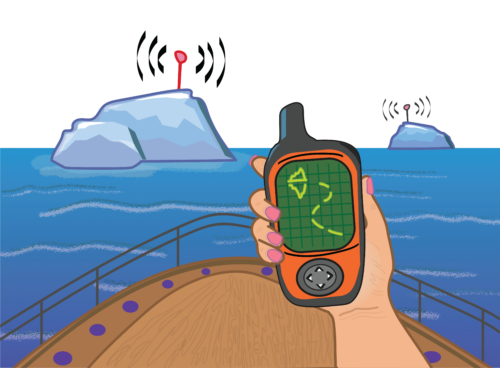Art Courtesy of Luna Aguilar
As climate change sends ocean temperatures soaring, the Greenland Ice Sheet is losing ice mass. With more ice melting now than at any time in recent history, unusually large volumes of cold, salt-free water mix into the ocean, wreaking havoc on the balanced cycles that sustain marine ecosystems and regulate weather patterns throughout the Arctic. Due to the critical role the ice sheet plays in our environment, scientists are eager to closely monitor its condition. To that end, scientists use predictive models that draw on data displaying the intricate circulation of water in our planet’s oceans, helping to chart the course of our planet’s climate future. One such model, showcased in a recent paper published by a team from the University of Maine and the University of Oregon, was built using GPS monitoring of icebergs in the Arctic. These data offer real-time information on water circulation as icebergs navigate busy waterways, hit unexpected barriers, and experience fluctuating weather patterns.
Kristin Schild, a researcher from the University of Maine and the second author of the study, sought to probe deeper into the environmental patterns affecting the Greenland Ice Sheet. Traditional methods of monitoring water circulation involve scientists deploying data-collection instruments deep in fjord waters adjacent to glaciers. However, when using this method, the instruments teeter on the brink of destruction, perpetually threatened by the relentless onslaught of colossal icebergs. This data collection challenge is particularly prevalent in Schild’s work, as she focuses on a historically iceberg-rich and data-poor fjord in West Greenland: the Ilulissat Icefjord. “This is a region that has lots of icebergs, and so traditional methods of monitoring currents were less feasible because we would risk expensive monitoring equipment each time we deployed instruments into the water,” Schild said.
Amid these challenges, Schild and her research team devised a novel method to address the limitations of traditional data collection techniques. Rather than stationing the equipment along the edge of the glaciers in Ilulissat Icefjord and risking iceberg collisions, the researchers placed GPS devices on the icebergs themselves. “We had to be a little bit more creative in terms of how we’re going to measure the circulation when we can’t use our normal oceanographic tools,” Schild said. “That’s when we had the idea to just put GPS trackers on icebergs as a natural tracker to understand the environment.” By employing this method, the researchers kept these devices out of harm’s way as the icebergs themselves became natural trackers for water circulation.
The joint research team deployed GPS units on thirteen icebergs in the Ilulissat Icefjord in the summers of 2014 and 2019 to explore the water circulation more deeply. “We had to deploy the GPS by helicopter, and I got to be the team member to jump out of the helicopter to install the GPS devices,” Schild said. “It was really exciting from an adventure standpoint of doing this thing—instrumenting icebergs with GPS—that hasn’t been done before, but also in terms of testing a novel scientific approach of using icebergs to understand the environment.”
Combining the fjord data from these two summers, the joint research team was able to uncover a correlation between tributary fjord runoff, or glacier meltwater from neighboring fjords, and the direction and speed of currents in the Ilulissat Icefjord. This relationship had escaped detection from previous circulation studies. Schild’s innovative approach to monitoring may also reveal other new relationships that can contribute to our understanding of water circulation dynamics. “[This study is part of] a bigger effort to produce more representative global circulation models so that we can better predict what will happen to the Greenland Ice Sheet in the future,” Schild said.
Developing precise, predictive climate models for the Greenland Ice Sheet is crucial since the ice sheet’s response to climate change has critical implications beyond the Arctic. “Iceberg research is continuing to move forward, and it’s really exciting,” Schild said. “We’re working with many other iceberg scientists to figure out how we can more efficiently track icebergs, like through automated tracking using satellite remote sensing data, and also how we can better integrate these data sets into models.” Each improvement deepens our understanding of the ice sheet’s dynamics and their connection to the global climate, highlighting the need for innovative research and advanced data processing to address climate challenges.

